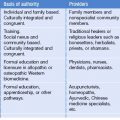CHAPTER 5 Language Assistance for Limited English Proficient Patients
Legal Issues
Introduction
Part One: Federal and State Laws Requiring Language Assistance
The Civil Rights Act of 1964, of which Title VI is a part, created broad national powers to end discrimination in employment, places of public accommodation (such as hospitals), and programs and activities that receive federal financial assistance. The legislative history of Title VI indicates that healthcare was prominent in the minds of its authors, as passage of the 1964 Act was contemporaneous with the judicial ruling in Simkins v. Moses H. Cone Memorial Hospital.5 Simkins was a landmark case in which the courts struck down as unconstitutional key portions of the Hill Burton Act which had authorized the use of federal funds to construct and operate segregated healthcare facilities.
Title VI of the Civil Rights Act of 1964 prevents federal money from being used to support activities and programs that discriminate on the basis of race, color, or national origin. Section 601 of Title VI states that no person shall ‘on the ground of race, color, or national origin, be excluded from participation in, be denied the benefits of, or be subjected to discrimination under any program or activity receiving Federal financial assistance.’6 Under section 602, the Department of Health and Human Services (HHS) has issued regulations that say recipients of federal funds can not:
[U]tilize criteria or methods of administration which have the effect of subjecting individuals to discrimination because of their race, color, or national origin, or have the effect of defeating or substantially impairing accomplishment of the objectives of the program as respect to individuals of a particular race, color, or national origin.7
In 1974, the US Supreme Court affirmed these regulations in Lau v. Nichols.8
Lau involved a San Francisco, California, school district that was desegregated under court order in 1971. The desegregation process left 1800 Chinese-American students who did not speak English in schools without supplemental English language courses. The Court recognized that ‘there is no equality of treatment merely by providing students with the same facilities, textbooks, teachers and curriculum, for students who do not understand English are effectively foreclosed from any meaningful education.’9 The Court held that the school district’s failure to take affirmative steps to provide language assistance constituted national origin discrimination under Title VI.10
Significantly, the key provisions of Title VI of the Civil Rights Act of 1964 have gradually been incorporated into virtually every major federal statute of significance to healthcare. For example, Title VI’s provisions have been incorporated into Medicaid, Medicare, Medicare Plus Choice, the State Children’s Health Insurance Program (SCHIP), the Hill Burton Act, the Community Health Centers Act, and the Maternal and Child Health Block Grant Programs. As a result, nearly every state and local government, health plan, hospital, and physician that receives federal monies is bound by Title VI. The requirements of Title VI apply to all recipients of federal funds, regardless of the amount of federal funds received. Further, HHS has enforced Title VI against healthcare organizations and providers that have failed to provide language assistance to LEP patients. The rationale for doing so is virtually the same as the Supreme Court’s analysis in Lau. According to HHS, ‘a recipient of Federal financial assistance that does not have the ability to communicate with LEP persons deprives such persons of an equal opportunity to participate and benefit from the federal program.’ As a result:
No persons may be subjected to discrimination on the basis of national origin in health and human services because they have a primary language other than English.11
Litigating language assistance requirements under federal law
Until recently, immigrants and other private litigants were permitted to sue to enforce Title VI regulations prohibiting acts with discriminatory effects. However, the United States Supreme Court in the 2001 case of Alexander v. Sandoval ruled that there is no private right of action under the Title VI regulations.12 Sandoval involved a class of non-English-speaking residents of Alabama who alleged that the state’s policy of offering the driver’s license exam only in English amounted to national origin discrimination under the previously mentioned ‘effects’ provision of the Title VI regulation. While the Court of Appeals for the Eleventh Circuit agreed, the Supreme Court ruled that private parties lacked the authority to file a lawsuit to enforce the effects provision of the Title VI regulation.
In the aftermath of Sandoval, immigrants and other private plaintiffs must now establish that the conduct in question amounts to intentional discrimination under Title VI (see endnote EN2).13 Significantly, however, while Sandoval applies to private parties, it has no effect on the federal government’s ability to pursue civil rights cases using the effects test under the Title VI regulation. The authority of agencies such as the Office for Civil Rights at the Department of Health and Human Services remains unchanged.
Although OCR’s track record of effectiveness may be less than inspiring, providers dare not take it for granted. According to Thomas E. Perez, Former Director, Office for Civil Rights at the US Department of Health and Human Services, language access cases are easily OCR’s most frequently encountered type of Title VI case.14 (Ironically, as Perez notes, the large number of OCR complaints may actually understate the true extent of the problem, as many immigrants are reluctant to file complaints.)
OCR representatives have indicated that the most frequently encountered language access problems are providers who: (1) directly or indirectly require patients to provide their own interpreter service, through family or friends; (2) fail to provide interpreter service, or provide untrained personnel; and (3) subject people with limited English skills to lengthy delays as a result of the lack of readily available interpreter services.16
Recent developments: Executive Order 13166 and DHHS guidance
In recent years, with immigration at record highs, there has been a spate of new federal developments with respect to the provision of language assistance services to immigrants. On August 11, 2000, President Clinton issued Executive Order 13166, entitled Improving Access to Services for Persons with Limited English Proficiency. Executive Order 13166 required every federal agency that provides federal assistance, including HHS, to publish a Title VI guidance to explain to recipients of federal funds how to provide access to LEP persons and achieve compliance with the Title VI regulations. The HHS Office of Civil Rights issued an initial guidance on this topic on August 30, 2000. Subsequently, on August 4, 2003, HHS published a revised Guidance to Federal Financial Assistance Recipients Regarding Title VI Prohibition Against National Origin Discrimination Affecting English Proficient Persons (2003 HHS LEP Policy Guidance).18 The Guidance made clear that it did not create new obligations, but rather clarified existing Title VI responsibilities.
Four-factor test to determine language assistance obligations
Guidelines for providing oral interpretation services to LEP patients
Where oral interpretation is needed, providers should develop procedures for providing competent interpreters in a timely manner. The DHHS Guidance describes various options for providing oral language assistance, including hiring bilingual staff or qualified staff interpreters, contracting for interpreters, using telephone interpreter lines, and using community volunteers. The Guidance makes clear that while providers may choose the means of communicating with the LEP patient, the result must be effective communication. While LEP patients may elect to use an interpreter of their own choosing, providers may not require LEP persons to use family members as interpreters.21
The DHHS Guidance discourages the use of family members, friends, and especially children as interpreters. ‘Extra caution’ should be taken when the LEP person chooses to use a minor to interpret.22 The use of family members and friends as medical interpreters is highly problematic and can compromise many aspects of patient care. While family members and friends may know more English than the patient, they may not understand medical terminology, and ad hoc interpreters are more likely than professional interpreters to commit errors of potential clinical consequences. (One case that exemplified this situation occurred in Minneapolis, Minnesota, where a 14-year-old Hmong girl tried to interpret for an older family member. The attending physician explained to the girl that further X-rays were needed, but the girl misunderstood and explained to the family that the physicians were planning to ‘microwave the patient.’) Using a family member or friend as an interpreter risks breaching patient privacy and confidentiality; patients may be less inclined to reveal sensitive personal or medical information when relatives or friends are present. Using minor children to interpret also upsets the traditional family hierarchy and can subject children to information that they are not emotionally or intellectually prepared to handle.
Legal duty to provide written translated materials – safe harbors
With respect to written translation, DHHS says it will determine compliance on a case-by-case basis, taking into account the ‘totality of the circumstances’ in light of the four-factor test. However, the DHHS Guidance makes clear that providers have a legal obligation to translate ‘vital written documents’ into the languages of the most frequently encountered LEP populations eligible to receive its services. ‘Vital documents’ may include: consent and complaint forms; intake forms with the potential for important consequences; written notices of rights, denial, loss, or decreases in benefits or services; notices of disciplinary action; applications to receive services or benefits; and notices advising LEP persons of their right to receive free language assistance services.23
Office of Minority Health cultural and linguistic access standards
In fact, HHS has already developed standards for culturally and linguistically appropriate services in healthcare. The Office of Minority Health began the process of developing national standards in 1997. On December 22, 2000, following a lengthy period of public comment and collaboration, the HHS Office of Minority Health issued National Standards on Culturally and Linguistically Appropriate Services (CLAS) in Health Care.26 The standards ‘are especially designed to address the needs of racial, ethnic, and linguistic population groups that experience unequal access to health services … [and] to contribute to the elimination of racial and ethnic health disparities.’
The CLAS standards contain 14 standards, organized into three themes: culturally competent care, language access services, and organizational supports for cultural competence. The 14 standards can also be categorized by their stringency as mandates, guidelines, and recommendations.27 Significantly, all of the mandates (Standards 4–7) deal specifically with language access. These standards are essentially restatements of existing Title VI law for purposes of recipients of federal funds and provide as follows:
The CLAS standards are independent of DOJ and OCR guidance documents. However, because they address many of the same issues in great detail and are aimed at healthcare providers, these standards are proving helpful to providers as they devise and implement language access plans. Already, the CLAS standards are being used widely. For instance, George Washington University Center for Health Service Research and Policy has released and widely circulated model cultural competence purchasing specifications for Medicaid managed care that are based on the CLAS standards. HHS has also made cultural and linguistic competence the focus of Medicare + Choice quality improvement projects and has encouraged health plans to use CLAS standards in developing their projects. While aimed at healthcare organizations, the standards are also presented as guidelines for accreditation and credentialing agencies such as the Joint Commission on Accreditation of Healthcare Organizations, the National Committee on Quality Assurance, and peer review organizations. Finally, to the extent that the CLAS standards represent the first national standards on culturally and linguistically appropriate healthcare services, it could be argued that these standards represent a new community standard for medical malpractice purposes.
State laws requiring language access
According to a National Health Law Program survey, 43 states have laws that address language access in healthcare settings.29 At least 26 states and the District of Columbia have enacted legislation requiring language assistance such as interpreters and/or translated forms and other written materials for LEP patients. For example, California statutes require interpreters or bilingual staff at general acute care hospitals, county medical health programs, and intermediate care facilities.30 Idaho requires interpreters for the purpose of obtaining consent from patients in the state’s Medical Assistance Program. Massachusetts enacted the ‘Emergency Room Interpreter Bill,’ effective as of July 1, 2001. The law requires all public and private acute care hospitals to provide ‘competent interpreter services’ for all emergency room services. Rhode Island requires hospitals to provide a qualified interpreter when a bilingual clinician is unavailable for all services given to every non-English-speaking patient. This law became effective January 1, 2002.31
A few states have used the law to implement broader cultural competency efforts. Recently, California has acknowledged the need for cultural competency by adding state administrative support for such efforts. A 1999 statute established an Office of Multicultural Health. The Office’s duties includes performing ‘an internal assessment of cultural competency, and training of healthcare professionals to ensure more linguistically and culturally competent care.’ A 2000 California law established ‘The Task Force on Culturally and Linguistically Competent Physicians and Dentists.’ The Task Force’s work has already generated additional legislation, including a bill to provide language and cross-cultural training to California physicians.32
Stay updated, free articles. Join our Telegram channel

Full access? Get Clinical Tree







